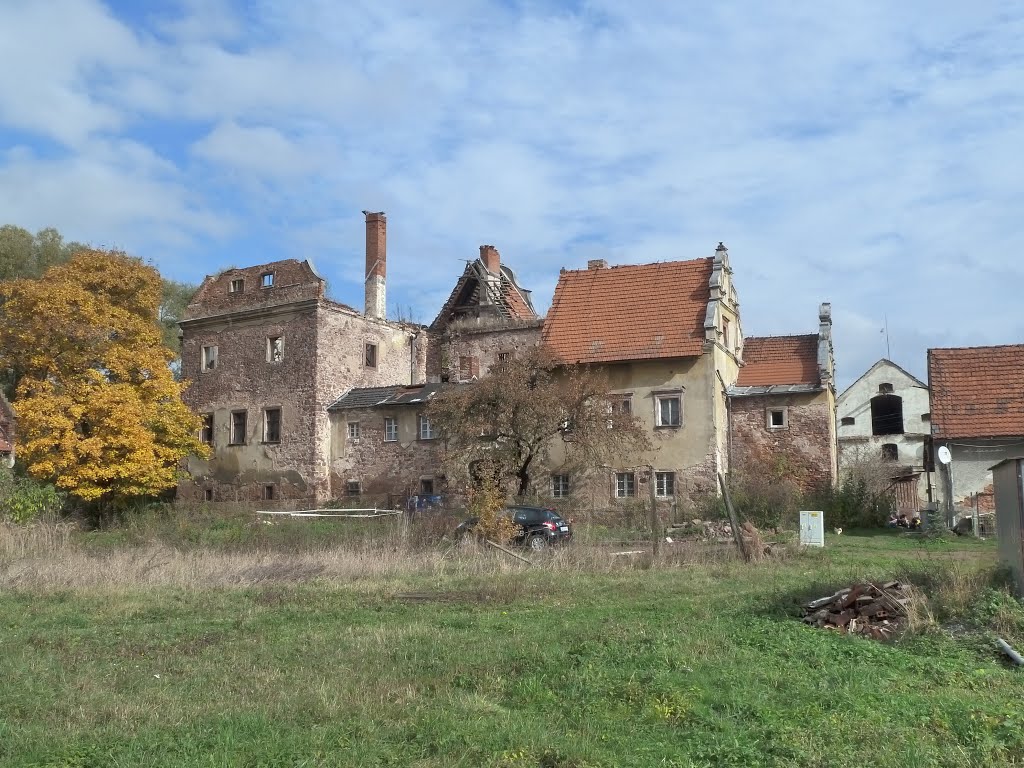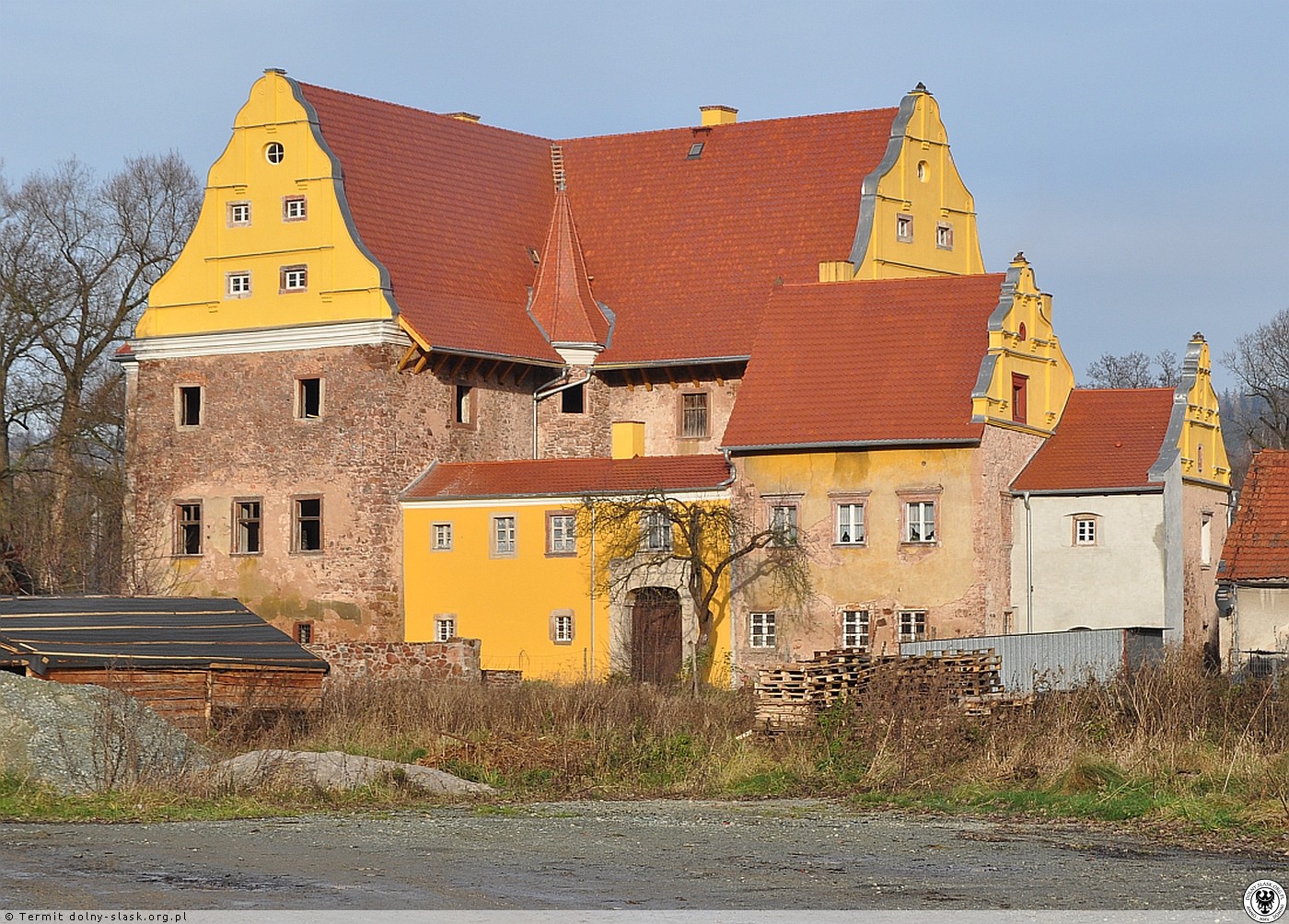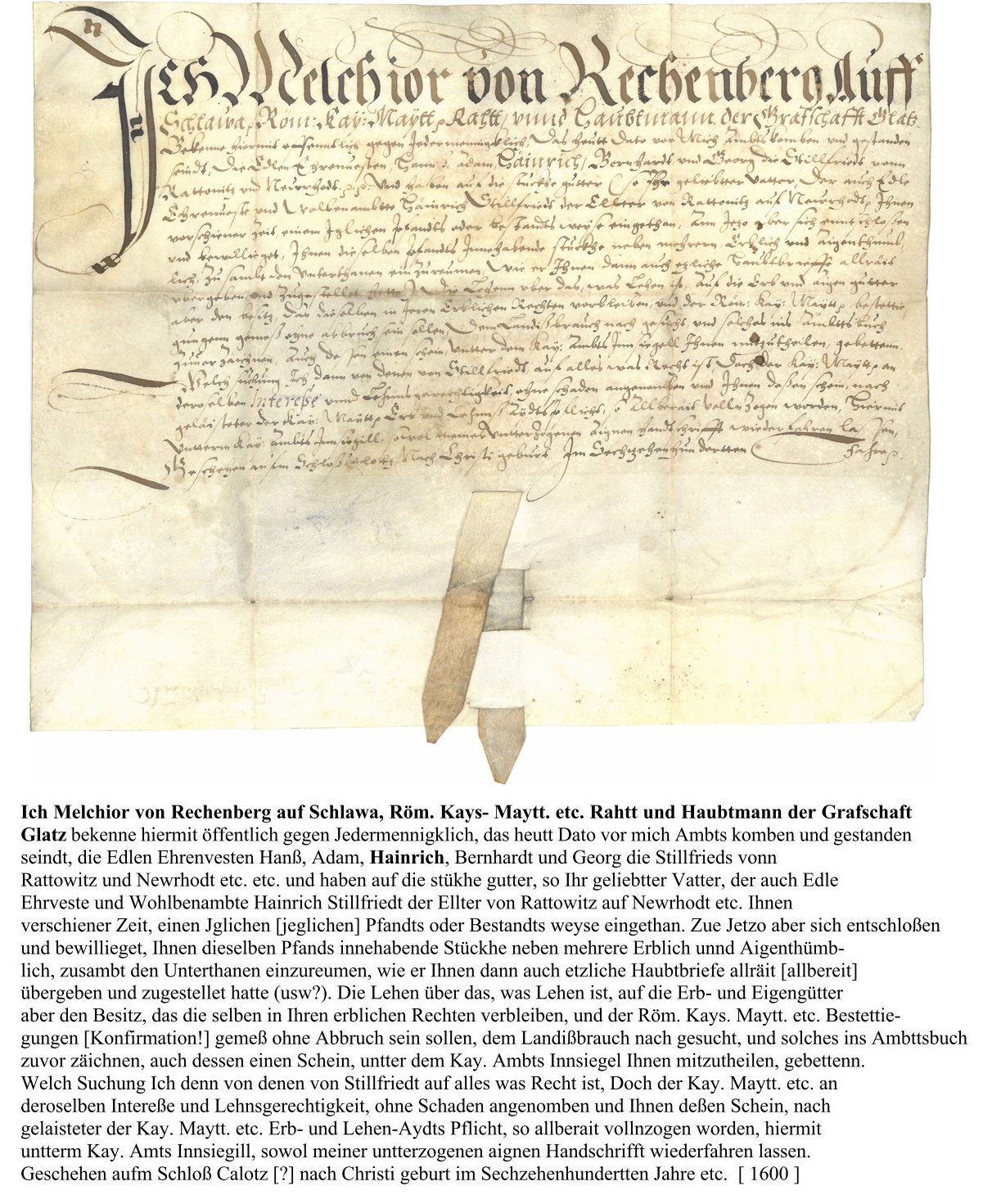Ścinawka Średnia (deutsch Mittelsteine) is a village in Powiat Kłodzki in the Wojewodschaft Niederschlesien in Polen. It belongs to the urban and rural municipality Radków (Wünschelburg) and lies at the confluence of the Posna (Pośna) and the Steine (Ścinawka).

The Oberhof
At the upper end of the village was the Oberhof, which from the end of the 17th century was also called the Hauptmannshof. In 1356, the brothers Thomas and Konrad von Czechau are recorded as the owners. Their descendants sold the estate to Stephan and Bernard von Donin in 1412. After the death of Friedrich von Donin in 1467, Mittelsteine and Neurode fell to the Bohemian King Georg von Podiebrad as a completed fief by reversion. He gave both fiefs to Georg Stillfried-Rattonitz out of gratitude for services rendered, with the condition that he marry one of the sisters of the deceased Friedrich von Dohna. The donation was confirmed in 1472. In an inheritance settlement between Jakob von Stillfried and his cousin Georg von Stillfried, the Mittelsteine estate fell to Jakob, who was married to Hedwig von Reichenbach. After Jakob's death around 1529, his son Heinrich von Stillfried (Heinrich the Elder) inherited the estate. He was married to Elisabeth von Pannwitz auf Albendorf and added further properties to the estate, including the Niederhof. After the death of his cousin Georg, who died childless, in 1586, he also acquired the Neurode feudal estate from Emperor Rudolf II. At his request, the Emperor turned the feudal estates of the Oberhof and Niederhof into a hereditary property in 1596. In 1598 Otto Friedrich von Ratschin auf Arnsdorf acquired both. After his death around 1601, the Mittelsteine estate was inherited by his two sons Otto Heinrich and Hans Friedrich. In 1612 they divided the inherited estates. Hans Friedrich received the Oberhof. In 1625, because of Hans Friedrich's participation in the Bohemian rebellion, the Oberhof was confiscated by the emperor and subsequently administered by the royal chamber. In 1636, the royal chamber sold the confiscated estate to Adam Christian von Ampassek, hereditary lord of Niederpischkowitz, who sold it to his brother-in-law Bernard von Stillfried auf Neurode in 1657. At that time, he was the administrator of the governorate of the county of Glatz. In 1658 he was appointed imperial councillor and in 1662 was raised to the rank of baron by Emperor Leopold I. He was married twice. He was married twice and left a daughter from each marriage after his death in 1669. Mittelsteine and the villages of Zaughals, Fichtig, Beutengrund and half of Königswalde were inherited by Anna Theresia, the daughter from the first marriage. In the same year she married Siegmund Erdmann von Zierotin, hereditary lord of Falkenberg. On behalf of his wife, he sold the Oberhof to the governor of the county of Glatz, Johann Georg von Götzen, in 1676. After him, the Oberhof was also called "Hauptmannshof". After the extinction of the male (Catholic) line of the Counts of Götzen with Johann Josef von Götzen in 1771, his three sisters inherited the estate, followed by his nephew Anton Alexander von Magnis in 1780. His descendants retained the Oberhof and the associated property until 1945.
Source: Wikipedia Ścinawka Średnia

Restoration 2015-2017 of the ruin by Iwona I Henryk Kryniccy
Impressive pictures of the interiors and cellar vaults can be found on the Facebooksite of the house
Plus a video on Facebook that shows the renovation works.
The following is a translation from Polish from the following site Kapitanowo - Schloss Mittelsteine
1524 - Jacob Stillfried becomes Lord of Oberhof through the division of his estates. He also owns the estates of Königswalde, Woliborz (Volpersdorf), Krajanow (Krainsdorf) and part of Ebersdorf.
1529 - Jacob Stillfried dies. The estate is inherited by his son Heinrich.
1540-50 - a second building in the form and function of a residential and defensive tower (11x12m) is erected, in a very rare trapezoidal shape connected to the main tower by a corner.
1550-60 - Addition of a large niche to the north wall of the main tower and a niche to the corresponding wall of tower no. 2. Construction of a stone staircase in the tower, polygonal tracery in the common corner.
1563-65 - negotiations and as a result of forcing (losses due to the floods caused by the damming of the Ścinawka River) the resale of the estate in Upper Ścinawka by Heinrich Stillfried for Heinrich Predel to Gregor von Reichenbach (1569) from the Peterwitz-Quickersdorf line around Ząbkowice.
1569 - enlargement of the estate by the lands adjoining the Oberhof manor and the forest of Biehals (Pieholz).
ca. 1570-75 - the estate is inherited by the son Heinrich Stillfried von Rattonitz.
1570-85 - a building is erected on the north side, connecting tower no. 2 and the large niche.
1577 - Heinrich Stillfried buys the forest of Zauchhols from Hans von Tschischwitz of Wojborz (Gabersdorf).
1585 - Heinrich Stillfried sells part of Dzikowiec to Absalon von Donig from Slupca.
1585-96 - The Great House in its final form. Addition of the north-eastern corner
1596 - Heinrich Stillfried changes the status of the Upper Court from a feudal estate to a hereditary estate. Because of the excessive costs incurred in the purchase of Nowa Ruda, he sold Oberhof to Otto Friedrich von Ratschin from Gorzanów (Arnsdorf) ( 1600). He lived there for another 18 years (Nowa Ruda).
1600 - Otto Friedrich von Ratschin dies, his wife Elisabeth née Schindel inherits the estate. Later the brothers of Ratschin become the rulers. After the division, Heinrich von Ratschin becomes lord of the manor.
1610-20 - Construction of the chancery building, the gate building (tower) and the curtain wall of the estate.
1623 - Heinrich von Ratschin loses the estate as a result of reprisals following speeches hostile to the emperor. The emperor gave the estate to his brother, Bishop Karl of Breslau.
1624 - Bishop Karl hands over Oberhof to his privy councillor and chancellor (later imperial court councillor) Johann Christian Metzinger von Falkenstein (Kaltenstein, Kalkstein) (1628)
1628 - after his death the estate was divided and became the property of his wife's siblings and the children of his two sisters
1639 - Christian von Apasseck from Piszkowice Dolne became the new owner of Oberhof.
1639-57 - a narrow, one-storey building was added to the circular wall. A magnificent stone three-flight staircase was built in the courtyard - the tract tower was extended and a chancery hall was built.
1657 - Oberhof is bought by Christian von Apasseck from his brother-in-law Bernhard von Stillfried Starszy, the Lord of Nowa Ruda, the head of the County of Kłodzko (later Imperial Councillor, from 1662 Baron) (1669).
1669 - Baron Bernhard von Stillfried dies. The castle falls to Bernhard's daughters Anna Theresia and Maria Florentina.
1670 - the manor of Oberhof as well as Zeughals, Sośnica (Fichtig), Bartnica (Beutengrund) and half of Königswalde go to the daughter Anna Theresia from her first marriage, who marries Siegmund Erdmann von Zierothin - the Lord of Niemodlin (Falkenberg) in 1669.
1676 - Siegmund Erdmann von Zierothin sells Oberhof as guardian of his wife to Johann Georg von Götzen - Imperial Count of Saren, Thurgmut and Bozkow - son of an Imperial Field Marshal, then Starost of the County of Kłodzko (1679).
1771 - Count Joseph Leonhard von Götzen dies. He dies at the castle in Ścinawka Śr. - At the same time, the Catholic line of the family dies out. The estate passes into the possession of Frederick William II, adjutant to the King of Prussia.
Wilhelm II - Friedrich Wilhelm von Götzen - general and governor of the Kłodzko fortress, descended from the Protestant line of the Brandenburg family (1794).
Mid-18th century. - A small part of the chancery is added in the south-west corner.
1780 - the castle passes into the possession of the Counts of Magnis from Bozkow - until the end of the Second World War.
1803 - a complete moat surrounds the castle - probably from the Middle Ages.
1876-1917 - the castle was leased around 1876 to the widow Tratwetter, 1891-1899 to Lichtenstädt, 1894-1909 to Carl Frank, around 1912 to the widow Augusta Frank and to the heirs of Edmund Bauch.
1824-1850 - the ditch becomes wider in the west, narrower in the south, around 1850 - the ditch is filled in.
1901 - probably a nice terrace was built, a second entrance with a new staircase and roofed - southwest corner.1935 - Date of the last renovation.
1946 - Nationalisation of the object and property - transformation into a state farm. Progressive degradation and destruction of the castle.
1982 - The state agricultural offices cease their activities. People still live there, weddings are celebrated there.
1999 - the last occupant - the office - moves out.
2002 - the castle has a new owner - restoration work begins with the aim of restoring the castle.




